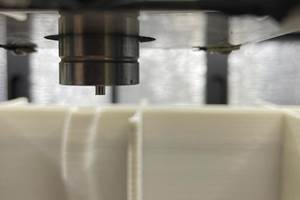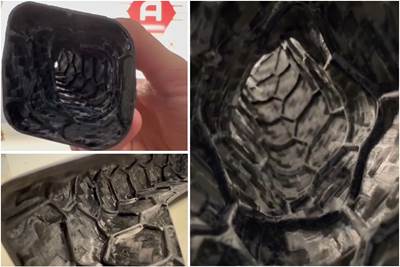Source (All Images) | Addyx
(Chieti, Italy) is the developer of the WSM-170 water-soluble expandable mandrel material that enables hollow composite structures. The material is converted into a filament and Addyx uses a standard fused deposition modeling (FDM) printer to fabricate the mandrel, which customers can then use to create hand layup prepreg parts or dry reinforcement preforms to use with resin infusion or resin transfer molding (RTM).
WSM-170 can also be used with Addyx’s patented Carbon Exoskeleton technology, which enables one-shot processing of fiber-reinforced composite ribs on the inside of molded hollow components. “We use a topology optimization program to analyze the composite part,” says Deborah Peca, customer care representative for Addyx. “We identify the areas of most stress and where higher density in ribs is needed, including areas for load transfer. We then complete the engineering of the part with the customer and the final positioning and pattern of the ribs in the 3D printed mandrel.”
During lamination, the ribs are laid first and then layup is completed. The ribs can use towpreg or unidirectional fiber, and Carbon Exoskeleton parts have also been made using filament winding. The completed layup can be cured using an autoclave, oven or heated press, and the mandrel is then dissolved in water with no chemical agents.
“We have also added rotomolding to produce mandrels for series production.”
“Carbon Exoskeleton is used to produce structural parts where the interior surface does not have to be smooth,” Peca notes. “The ribs on the inside of the hollow structure increase stiffness with less weight and cost versus using a sandwich core material or extra reinforcement plies. This approach can be used to upgrade tubular parts such as bicycle frame components, motorsports airfoils and hollow chassis members, as well as car seat structures. The key is that you are improving the stiffness in a very lightweight construction.”
The Carbon Exoskeleton technology enables varying the thickness, width and density of the ribs, says Peca, while topology optimization defines these parameters as well as their arrangement in the structure to ensure maximum strength with minimal material use and weight. Benefits include up to a 30% reduction in layup time and up to 15% less waste.
Notably, the WSM-170 mandrel withstands curing temperatures up to 180°C and becomes an expanding membrane with the application of pressure during curing. “This eliminates the need for an internal vacuum bag,” says Peca, “and enables excellent compaction as well as the ability to integrate not only ribs, but also fastening points, including metal fasteners.”
“We have also added rotomolding to produce mandrels for series production,” she continues. “The 3D printing method is more for prototypes and small series. Rotomolding offers larger volume production for applications in aerospace, for example. We are launching this new production process for mandrels and have started the first projects.”
The rotomolding process uses a machined aluminum mold from a supplier. “We put the WSM-170 polymer inside the mold, but in a powder form, which is also cheaper than converting it into a 3D printing filament,” says Peca. “We then heat and rotate the mold in the machine to create the mandrel, which is completed in 20-30 minutes. We can produce a large quantity of mandrels per day at an affordable cost.”
Related Content
Carbon fiber satellite arm reduces weight, simplifies assembly onto naval vessels
Satcom developer EM Solutions partnered with ACS Australia to replace an aluminum arm design with a 65% lighter, one-piece, corrosion-resistant carbon fiber/epoxy alternative.
Read MoreMold 3D printing helps automate composite bathtub, shower production
As part of its efforts to automate as much of its production process as it can, Lyons Industries acquired a Massivit 10000 additive manufacturing system to quickly produce high-performance molds and support fixtures.
Read MoreScaling up thermoplastic composites recycling
Thermoplastic composites are always said to be “recyclable.” Netherlands-based recycler Spiral RTC discusses the process, challenges, applications and opportunities to building a real recycling ecosystem.
Read MoreComposite wrap system combats corrosion in industrial tank repair
A fiberglass and carbon fiber composite wrap system enabled an Australian nickel mine to quickly repair a stainless steel ammonium sulphate feed tank and protect against future corrosion.
Read MoreRead Next
Addyx carbon exoskeleton technology enables molded ribs inside hollow composite structures
Using a water-soluble mandrel, carbon exoskeleton opens paradigm for topology-optimized composites, cutting weight, manufacturing time and scrap rate.
Read MoreUltrasonic welding for in-space manufacturing of CFRTP
Agile Ultrasonics and NASA trial robotic-compatible carbon fiber-reinforced thermoplastic ultrasonic welding technology for space structures.
Read MoreScaling up, optimizing the flax fiber composite camper
Greenlander’s Sherpa RV cab, which is largely constructed from flax fiber/bio-epoxy sandwich panels, nears commercial production readiness and next-generation scale-up.
Read More













